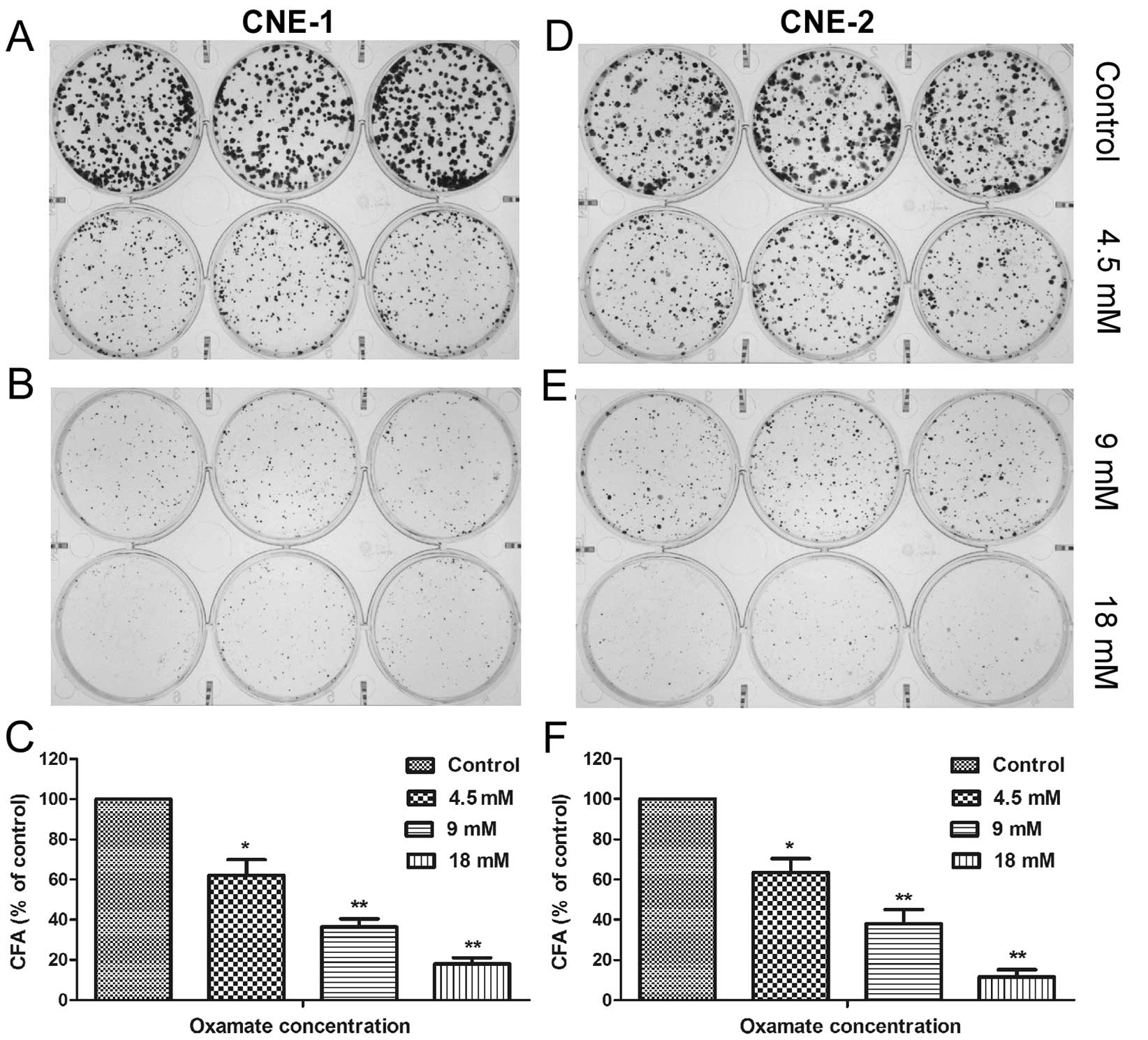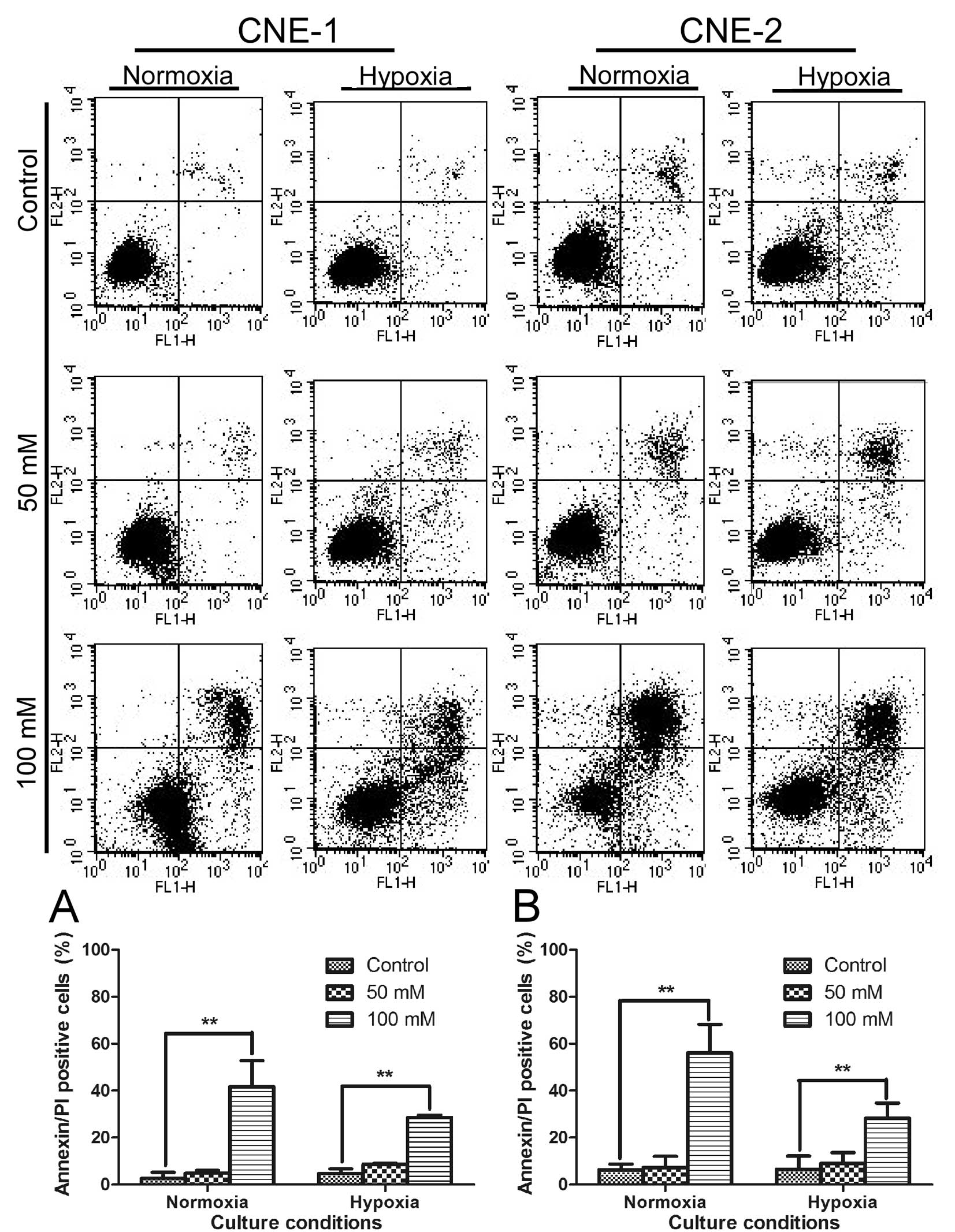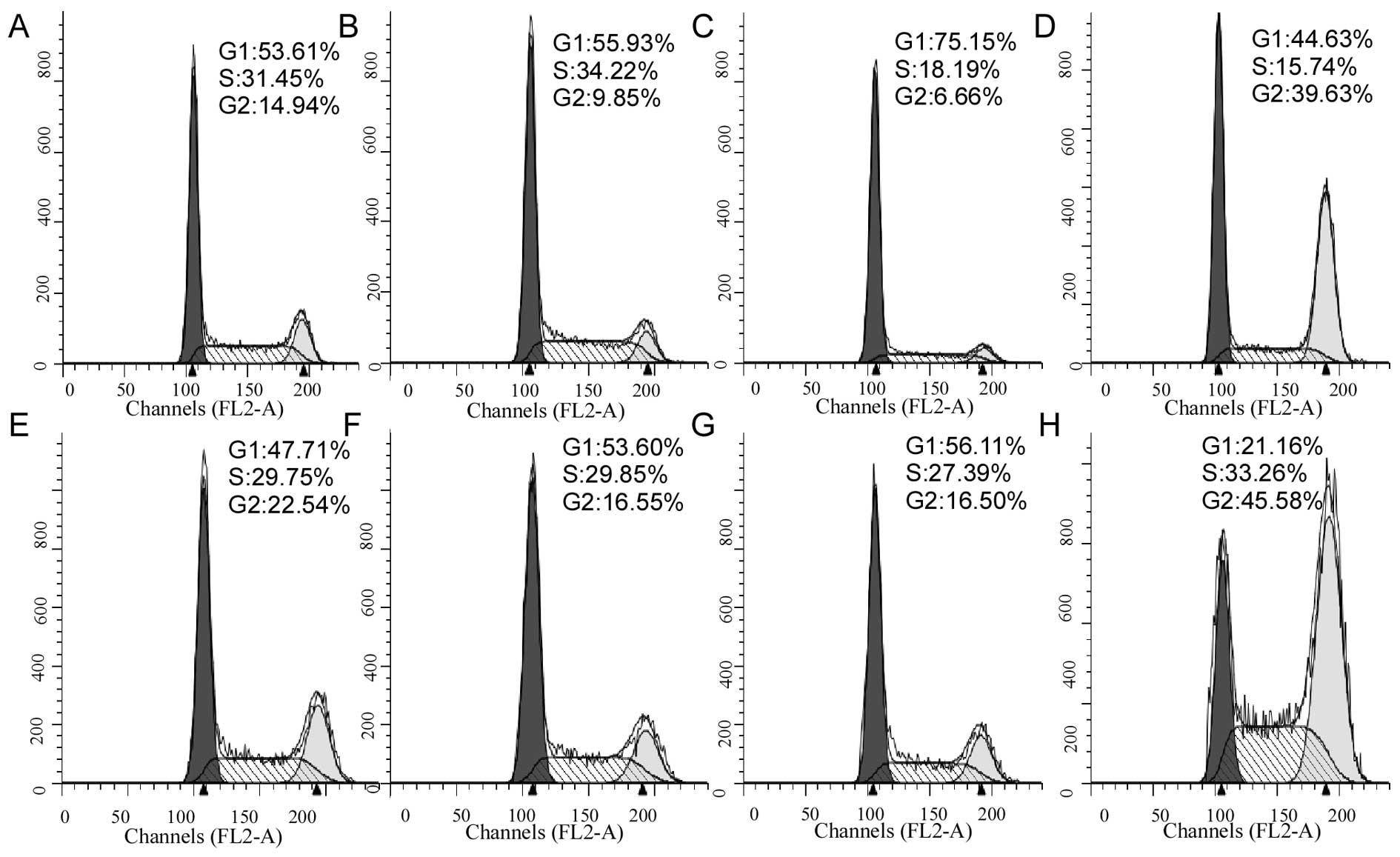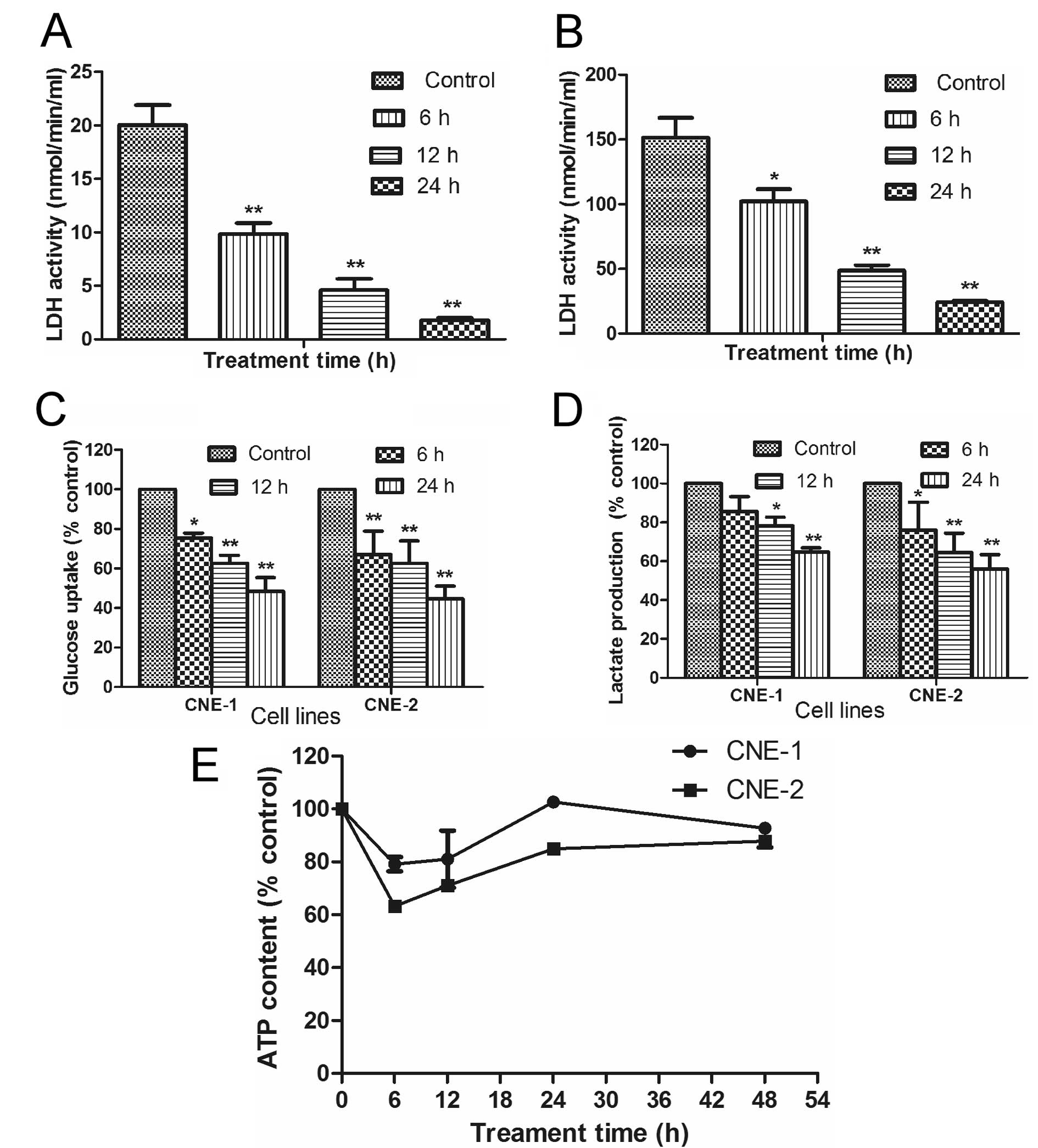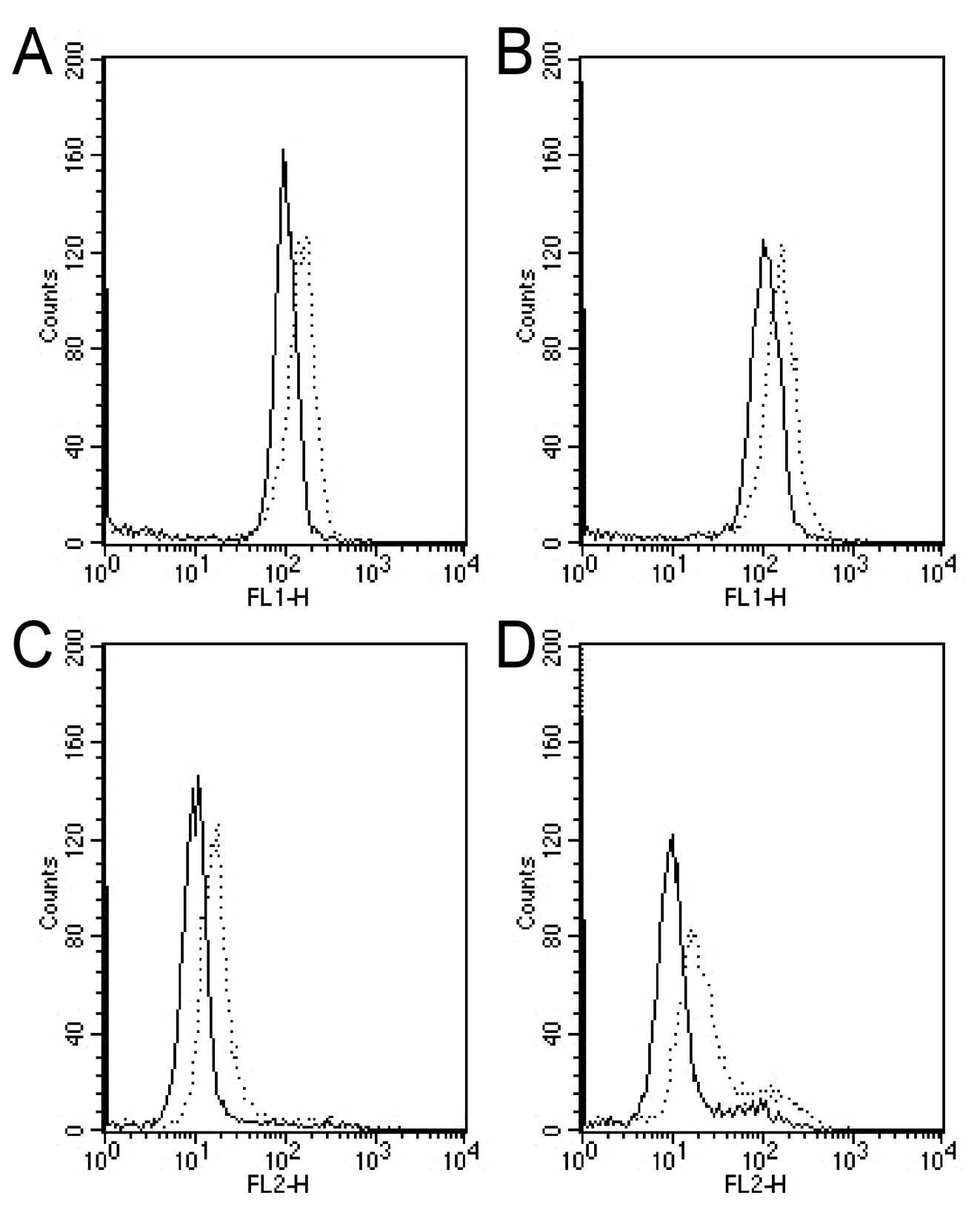Effective inhibition of nasopharyngeal carcinoma in vitro and in vivo by targeting glycolysis with oxamate
- Authors:
- Published online on: August 27, 2013 https://doi.org/10.3892/ijo.2013.2080
- Pages: 1710-1718
Abstract
Introduction
Nasopharyngeal carcinoma (NPC) is a malignancy with unique geographic distribution and is most common in certain areas of Asia such as the southern part of China (1). In clinical practice, early detection of NPC still remains a major challenge and many NPC patients are diagnosed in the advanced stage with limited treatment options. This situation contributes to the relatively high mortality of NPC. Currently, the therapeutic options of NPC include chemotherapy, radiotherapy and chemoradiotherapy (2). Despite the significant progress in our understanding of NPC genetics and disease development, the therapy of NPC still remains to be a great challenge due to drug resistance, disease relapse and metastasis. The high toxicity of conventional chemotherapy and radiotherapy also affects the quality of life of NPC patients (3,4). Therefore, it is of great importance to develop novel and effective therapeutic strategies that specifically kill NPC and is tolerated by normal cells (3). Metabolic intervention based on the unique metabolic alterations in cancer cells is one of the attractive therapeutic strategies with high anticancer activity and selectivity.
One of the major metabolic alterations in cancer cells is elevation in aerobic glycolysis, a phenomenon known as the Warburg effect observed many decades ago (5). The increase in glucose uptake by cancer cells constitute the key biochemical basis of 18fluorodeoxyglucose positron emission tomography (FDG-PET) for clinical diagnosis of cancer (6). Although the exact reasons for the preference of cancer cells to use the glycolytic pathway still remain to be investigated, this altered energy metabolism may represent a vulnerability of cancer to therapeutic intervention (7). Similar to many other cancer types with high FDG-PET signal (6,8), NPC cells seem to be highly active in glycolysis and can be readily detected using FDG-PET scan, which in fact has been used for diagnosis and prognosis evaluation of NPC with high standard uptake values (SUV) being associated with poor prognosis (9). This is consistent with the recent study suggesting that active aerobic glycolysis occur in the head and neck squamous carcinoma (10). However, it remains unclear if the active glycolytic activity in NPC cells could be exploited for therapeutic purpose and the key enzymes in the glycolytic pathway that may be targeted to kill NPC cells remain to be investigated.
Lactate dehydrogenase (LDH) is an enzyme that catalyzes the conversion of pyruvate to lactate and thus significantly affect the glycolytic metabolism. Interestingly, the expression of LDH has been found to be an independent prognosis biomarker in different cancers including NPC (11,12). Furthermore, the level of LDH seemed to be associated with NPC bone metastasis (13). Knockdown of LDH has been shown to cause inhibition of tumor growth in vitro and in vivo in several types of human cancers (14–18), indicating an association between elevated glycolytic activity and the malignant behavior of NPC cells. These observations suggest that LDH may be a key enzyme that plays an essential role in energy metabolism in NPC cells and that it may be possible to target this enzyme as a therapeutic strategy for treatment of this malignant disease. In the present study, we showed that inhibition of LDH by oxamate led to significant suppression of glucose uptake and lactate generation and inhibited NPC growth in vitro and in vivo. We also found a drug combination strategy that is highly effective in abrogating energy metabolism in NPC cells and significant therapeutic implications.
Materials and methods
Reagents
Oxamate was purchased from Sigma-Aldrich. LDH activity detection kit was purchased from Biovision (San Francisco, CA, USA). Strips for glucose and lactate detection were the product of Roche (Mannheim, Germany). Annexin V/PI staining reagents were purchased from Keygene (Nanjing, China). MitoSOX and Rhodamine-123 were from Molecular Probes (OR, USA). ATP detection kit was purchased from Promega (Madison, WI, USA).
Cell culture
Human nasopharyngeal carcinoma cell lines CNE1 and CNE2 were cultured in DMEM medium supplemented with 10% FBS. The immortalized nasopharyngeal epithelial cells (NP69) were cultured in keratinocyte-SFM medium (Invitrogen) supplemented with bovine pituitary extract (BD Biosciences). A hypoxic culture condition was created by incubating cells in a sealed modular incubator chamber (Billups-Rothenberg, Del Mar, CA, USA) flushed with a gas mixture containing 5% CO2 and 95% N2. Because the culture flasks contained ambient oxygen at the beginning of the experiments, the final oxygen content in the hypoxia chamber was ∼0.5–1% after achieving air equilibrium as described previously (19).
MTT assay
Cells in logarithmic growing phase were seeded in 96-well plates with 3,000 cells in each well. Various concentrations of oxamate were added to the wells and the plates were placed in a cell culture incubator for 72 h. The samples were then incubated with MTT reagent (20 μl/well) and incubated for another 4 h. After the culture medium was removed, the cells were lysed with 200 μl DMSO to dissolve the purple formazan and the OD values were detected at the wavelength of 570 nm as described previously (20).
Colony formation assay
Cells in logarithmic phase were seeded in 6-well plates with 500 cells in each well. Various concentrations of oxamate were added to the wells. The cells were cultured for two weeks before fixation and staining with crystal violet. The samples were photographed and the colonies were counted as described previously (21).
Annexin V/PI assay
Apoptosis was detected using Annexin V/PI double staining as described previously (20). After the drug treatment, cells were harvested, washed and counted. The cells were then stained with Annexin V and PI in binding buffer for 15 min and cell viability was analyzed using the FACSCalibur flow cytometer (BD Co., USA).
Cell cycle analysis
Cells in logarithmic phase were seeded in 6-well plates with a density of 2×105 cells per well. Different concentrations of oxamate were added and the plates were incubated for 24 h. The cells were harvested and fixed with 75% alcohol at 4°C for 4 h and then incubated with RNase at 37°C for 30 min followed by addition of PI. Finally, cell cycle distribution were detected by using the BD FACSCalibur flow cytometer (22).
Glucose uptake and lactate production assays
Cells were seeded in 6-well plate with the density of 2×105 cells/well. After the indicated incubation periods, medium was removed for measurement of glucose and lactate concentrations using the Roche Accurend Analyzer (Roche) as previously described (23). Experiments were repeated for at least three times.
Assay of cellular ATP
Cells in logarithmic growth were seeded in 96-well opaque plates with the density of 50,000 cells per well. Oxamate (50 mM) was added and the plates were incubated for 6, 12, 24 or 48 h. Cellular ATP contents were measured using the Promega ATP detection kits according to the procedures recommended by the manufacturer. Luminescence (relative light unit) was detected by a luminescent plate reader as previously described (23). ATP contents in the samples were calculated according to the standard curve.
Reactive oxygen species (ROS) and mitochondrial transition potential (MTP) detection
Cells were stained for 30 min with DCF-DA for ROS detection or Rhodamine-123 for MTP detection. The samples were harvested and analyzed using a BD Calibur flow cytometry as described previously (24).
LDH activity assay
LDH activity was analyzed as described previously (25). Briefly, cells were washed, homogenized and centrifuged. The supernatant was added into a 96-well plate. After addition of the reaction mix, enzyme reaction was initiated and OD value was detected at the wavelength of 450 nm. LDH activity was calculated as described previously (26).
Animal study
Balb/c nude mice (age 4–6 weeks) were purchased from the Laboratory Animal Center of Guangdong Province. Animal study was performed according to a research protocol approved by the ethics committee of the laboratory animal research of Sun Yat-Sen University Cancer Center. Two million CNE-2 cells were inoculated into the right flank of the mice. When the average tumor volume reached 100 mm3, the mice were divided into two groups, a control group and the oxamate-treatment group (with 5 mice in each group). Oxamate was given by i.p. injection (750 mg/kg, daily) as described previously (25). The control group was administered with PBS. The mouse body weights and tumor volumes were measured twice weekly. At the end of the experiment, mice were sacrificed and the tumors were excised for pathological examination. The tumor volume was calculated according to the following formula: Tumor volume (mm3) = ab2/2, where a and b represent the long and short diameter of the tumor, respectively.
Statistical analysis
Data are presented as the means and SD of at least three independent measurements. Statistical analysis (one way ANOVA or unpaired t-test) was used to determine differences between means of different experimental groups. Significance level for all statistical comparisons was set at P<0.05. Graph pad Prism 5.0 software (US) was used to draw pictures. Canvas X (US) was used to align and process pictures.
Results
Selective anti-proliferative effect of oxamate against NPC cells
We first used MTT assay to evaluate the effect of oxamate treatment on the proliferation of two human NPC cell lines (CNE-1 and CNE-2). The results showed that oxamate caused a strong inhibition of proliferation in nasopharyngeal carcinoma cell lines in a dose-dependent manner (Fig. 1). CNE-1 and CNE-2 exhibited similar sensitivity to oxamate with the IC50 values of 3.6±0.75 and 4.80±0.95 mM, respectively. Intriguingly, the cytotoxicity of oxamate against immortalized human normal nasopharyngeal epithelium NP-69 cells was markedly less (higher IC50 value, 30 mM) compared to malignant NPC cell lines (P<0.05), indicating a preferential inhibitory effect of oxamate against NPC cells (Fig. 1). We also used colony formation assay to further evaluate the effect of oxamate on the colony forming ability of NPC cells. The results showed that oxamate was able to effectively suppress colony formation of NPC cells in a concentration-dependent manner, with >80% of colonies lost when treated with 18 mM oxamate in both NPC cell lines (Fig. 2, P<0.01).
Induction of apoptosis by oxamate in NPC cells
We then further tested if the strong anti-proliferative activity of oxamate was due to cytotoxic effect or cytostatic effect. Annexin V/PI double-staining assay was first used to test if oxamate can directly induce apoptotic cell death in NPC cells under normaxic and hypoxic conditions. The results indicated that oxamate at high concentrations (50–100 mM) was able to induce apoptosis in both CNE-1 and CNE-2 under normoxia (Fig. 3, P<0.01). Interestingly, this compound seemed also effective in causing apoptosis under hypoxia (1% oxygen), although at a slightly lower rate (Fig. 3, P<0.01).
Cell cycle analysis to test the potential effect of oxamate on cell cycle progression
As shown in Fig. 4, oxamate at the concentrations of 25–50 mM did not significantly affect cell cycle distributions (Fig. 4C–G), while a higher concentration (100 mM) induced cell cycle arrest at G2 phase in both CNE-1 cells (Fig. 4D) and CNE-2 cell (Fig. 4H).
Oxamate inhibits glycolytic activity in NPC
Since oxamate is an inhibitor of lactate dehydrogenase (LDH), we tested if this compound could affect glucose uptake and lactate generation, two key indicators of glycolytic activity, in NPC cells. The ability of oxamate to inhibit LDH activity was first confirmed in two NPC cell lines. As shown in Fig. 5A and B, incubation of CNE-1 and CNE-2 cells with 50 mM oxamate resulted in a time-dependent inhibition of LDH in both cell lines (P<0.01). Interestingly, the basal LDH activity in CNE-2 cells (150 U) was significantly higher than that of CNE-1 (20 U), which could be a reason for the higher sensitivity of CNE-2 cells to oxamate in apoptotic response (Fig. 3) and cell cycle arrest (Fig. 4), since this cell line might be more dependent on LDH.
To further evaluate the impact of oxamate on glucose energy metabolism in NPC cells, we analyzed the effect of this compound on glucose uptake, lactate production and cellular ATP contents. Incubation of NPC cells with oxamate caused a time-dependent decrease in glucose uptake (Fig. 5C, P<0.05) and lactate production (Fig. 5D, P<0.05) in both CNE-1 and CNE-2 cell lines. Such decrease was consistent with the time-dependent inhibition of LDH enzyme activity (Fig. 5A and B). Interestingly, inhibition of glycolysis by oxamate only caused a transient decrease in cellular ATP by 20–40% during the first 6–12 h and cellular ATP levels restore to the control levels by 24–48 h (Fig. 5E, P>0.05). These data together suggest that NCP cells were able to compensate the loss of ATP due to glycolytic inhibition by upregulation of another energy production pathway such as oxidation phosphorylation in the mitochondria.
Oxamate induces an increase in mitochondrial transmembrane potential and ROS
The potential effect of oxamate on mitochondria functional status was tested in two NPC cell lines. As shown in Fig. 6, we used two fluorescent probes the Rhodamine-123 and Mito-SOX to evaluate the effect of oxamate on mitochondrial transmembrane potential (MTP) and reactive oxygen species (ROS), respectively, and showed that treatment of NPC cells with 50 mM oxamate induces a significant increase in MTP and ROS levels both in CNE-1 and CNE-1 cells (Fig. 6, P<0.05). These changes seem to suggest that the mitochondrial metabolic activity might be increased in response to inhibition of glycolysis in the cytosol to compensate ATP generation. This possibility was further confirmed by drug combination study in which inhibition of mitochondrial respiration by rotenone significantly enhances the effect of oxamate in terms of ATP depletion and cytotoxicity.
Inhibition of mitochondrial respiration in combination with oxamate leads to synergistic ATP depletion and cytotoxicity in NPC cells
Mitochondrial oxidative phosphorylation and glycolysis in cytosol are two major pathways that produce cellular ATP. Based on the observations that oxamate inhibited glycolysis and caused an increase in mitochondrial ROS and MTP, we postulated that glycolytic inhibition by oxamate might cause a compensatory increase in mitochondrial ATP generation, which prevented ATP depletion and massive cell death. To investigate this possibility, we used rotenone, a specific inhibitor of mitochondrial respiratory chain complex I, in combination with oxamate and tested their combined effect on cellular ATP and cell viability. As shown in Fig. 7, a sub-toxic concentration of oxamate (3.15 mM) or a sub-toxic concentration of rotenone (10 nM) alone did not cause any significant depletion of ATP in CNE-1 cells (Fig. 7A) or CNE-2 cells (Fig. 7B, P<0.01). Combination of both compounds at the same concentrations led to a synergistic depletion of cellular ATP and massive loss of cell viability by >80% in both cell lines (Fig. 7C and D, P<0.01). These results together suggest that NCP cells might be able to utilize glycolysis and oxidative phosphorylation to compensate for the loss of ATP if one of these metabolic pathways is inhibited and that a simultaneous inhibition of both pathways would be highly effective in killing NPC cells.
Antitumor activity of oxamate in vivo
Animal experiments were performed to test the potential therapeutic activity of oxamate against NPC. CNE-2 cells were inoculated subcutaneously (2 million cells/injection) into the right flanks of nude mice. When the tumor volume reached approximately 100 mm3, the mice were divided into two groups (5 mice/each). The treatment group received oxamate injection (750 mg/kg, i.p.) daily, while the control group received PBS treatment. As shown in Fig. 8A, oxamate treatment substantially inhibited tumor growth. At the end of the experiment, tumors were removed for weighing. The average tumor weights in the oxamate-treated group were significantly less than that of the control group (P<0.01, Fig. 8B, P<0.01). The daily oxamate treatment seemed well-tolerated by the animals and there was no significant loss of body weights (Fig. 8C, P>0.05). These data together suggest that oxamate may have potential for treatment of NPC.
Discussion
Accumulating evidence suggests that metabolic alterations are one of the important hallmarks of cancer and that such biochemical changes may be exploited for therapeutic purpose (26). Increase in aerobic glycolysis is perhaps the most prominent metabolic alteration observed in cancer cells with potentially significant therapeutic implications in clinical cancer treatment (27). Several small molecular weight compounds such as 2-deoxyglucose, 3-bromopyruvate, lonidamine and oxamate have been shown to inhibit glycolysis with significant anticancer activity in vitro and in vivo (28). Owing to the promising anticancer effects of glycolytic inhibitors observed in cell culture and in animal tumor models, it would be important to evaluate glycolytic inhibitors in clinical setting and to further develop new generation of compounds with better therapeutic potential. In this research area, several metabolic targets and inhibitors are emerging (29,30).
Among the small compounds that inhibit cancer energy metabolism, oxamate was initially identified over 40 years ago as an inhibitor of LDH (31). Inhibition of LDH by oxamate causes a decrease in lactate production and suppression of cancer cell proliferation. In our study, we showed that oxamate was able to kill NPC cells both in normoxic and hypoxic conditions (Fig. 3). This is important because many conventional anticancer drugs become less effective in hypoxia and thus compounds capable of killing cancer cells in hypoxia would potentially be useful to overcome hypoxia-induced drug resistance. Mechanistically, hypoxic cells are more dependent on glycolysis to generate ATP due to limited availability of oxygen for oxidative phosphorylation. As such, glycolytic inhibition is expected to be effective in killing hypoxic cells. Previous study indeed suggested that hypoxia rendered cancer cells sensitive to glycolytic inhibitors (32). It is possible, however, that induction of HIF-1α by hypoxia and activation of Akt and other survival molecules may protect tumor cells from the cytotoxic effect of oxamate to some degree.
Previous study showed that high expression of LDH in breast cancer cells was associated with active glycolysis and resistance to taxol and that inhibition of LDH by oxamate sensitized the tumor cells to taxol (33). Interestingly, it was shown that the high expression of ErbB2 in breast cancer cells promoted LDH expression and that oxamate was able to effectively kill these breast cancer cells with Erb2 overexpression (34). Furthermore, breast cancer cells resistant to trastuzumad (a drug that suppresses Erb2 signaling) was found to overexpress LDH and inhibition of LDH by oxamate or by RNAi sensitized these cancer cells to trastuzumad (25). The important role of glycolytic inhibition in sensitization of cancer cells to chemotherapy and radiotherapy has also been demonstrated in other experimental systems (35,36). These data, together with our observations that oximate was effective in killing NPC cells in vitro and suppressing NPC tumor growth in vivo, show the promising therapeutic potential of using oxamate in cancer treatment. However, it should be noted that the effective concentrations of oxamate required to kill cancer cells are very high (in mM range), which might limit its clinical use. The development of more effective LDH inhibitors such as Galloflavin with potent anticancer activity (37) may provide a solution.
In this study, oxamate exhibited selective cytotoxic effect against NPC cells with less cytotoxicity toward immortalized human nasopharyngeal epithelial cells (NP-69) in vitro and was well-tolerated in animals, suggesting that normal cells are less sensitive to glycolytic inhibition, likely due to their normal mitochondrial function and less dependence on glycolysis. We showed that oxamate could inhibit the glucose uptake and lactate production and that such glycolytic inhibition could be observed as early as 6 h, which was much earlier than the appearance of apoptosis. These observations together suggest that inhibition of glycolysis was a primary event leading to cell death. In addition to glycolytic inhibition, we also observed that oxamate caused changes in mitochondria as evidenced by an increase in mitochondrial transmembrane potential and ROS generation (Fig. 6). The mechanisms responsible for oxamate-induced mitochondrial changes and their role or contributions to the cytotoxic action of oxamate remain unclear and require to further investigation. A recent study showed that oxamate was able to inhibit aspartate aminotransferase (34), suggesting that this compound may have multiple cellular targets.
Interestingly, we observed that inhibition of glycolysis by oxamate caused a short-term decrease in cellular ATP by 20–40% during early drug exposure time period (6–12 h), but cellular ATP contents recovered to the normal level by 24–48 h, suggesting that NPC cells (CNE-1 and CNE-2) were able to compensate the loss of ATP due to glycolytic suppression by oxamate. The mechanism responsible for this metabolic compensation was likely through activation of mitochondrial oxidative phosphorylation, since inhibition of mitochondrial respiratory chain by rotenone in combination with oxamate caused a severe depletion of cellular ATP and massive loss of cell viability (Fig. 7). These data suggest that such mechanism-based drug combination might have potential to improve therapeutic activity in NPC treatment. This is consistent with the recent findings that a combination of mitochondria-targeted drugs and the glycolytic inhibitor 2-deoxyglucose exhibit synergistic effect against breast cancer cells (38).
In conclusion, we showed that oxamate was able to inhibit glucose uptake and lactate generation in NPC cells. This compound exhibited significant anticancer activity against NPC cells in vitro under normoxia and hypoxia and suppressed tumor growth in vivo. Activation of mitochondrial oxidative phosphorylation seems to be a compensatory mechanism that may compromise the ability of oxamate to kill NPC cells. Combination of oxamate with an inhibitor of mitochondrial respiration showed strong synergistic activity. It is important to further test the promising therapeutic activity of this novel drug combination in animals. It is also critical to test the potential cytotoxic effect of such drug combination in normal cells and in animal toxicology study to evaluate the therapeutic selectivity of this novel drug combination.
Acknowledgements
The authors thank Mingli Peng of Sun Yat-Sen University Cancer Centre for assistance with mouse husbandry. This study was supported in part by a grant from the major science and technology project of the National Basic Research Program of China (973 Program grant no. 2012CB967004).
References
|
Huang TR, Zhang SW, Chen WQ, et al: Trends in nasopharyngeal carcinoma mortality in China, 1973–2005. Asian Pac J Cancer Prev. 13:2495–2502. 2012.PubMed/NCBI | |
|
Cheng SH, Jian JJ, Tsai SY, et al: Prognostic features and treatment outcome in locoregionally advanced nasopharyngeal carcinoma following concurrent chemotherapy and radiotherapy. Int J Radiat Oncol Biol Phys. 41:755–762. 1998. View Article : Google Scholar | |
|
Toh HC, Ha TC and Wee J: Personalised medicine in nasopharyngeal cancer. Lancet Oncol. 13:568–569. 2012. View Article : Google Scholar : PubMed/NCBI | |
|
Ayyanathan K, Kesaraju S, Dawson-Scully K and Weissbach H: Combination of sulindac and dichloroacetate kills cancer cells via oxidative damage. PLoS One. 7:e399492012. View Article : Google Scholar | |
|
Warburg O: On the origin of cancer cells. Science. 123:309–314. 1956. View Article : Google Scholar : PubMed/NCBI | |
|
Jadvar H: Imaging evaluation of prostate cancer with (18)F-fluorodeoxyglucose PET/CT: utility and limitations. Eur J Nucl Med Mol Imaging. 40(Suppl 1): 5–10. 2013. View Article : Google Scholar : PubMed/NCBI | |
|
Schulze A and Harris AL: How cancer metabolism is tuned for proliferation and vulnerable to disruption. Nature. 491:364–373. 2012. View Article : Google Scholar : PubMed/NCBI | |
|
Erdem V, Selimoglu Sen H, Komek H, et al: Prognostic factors in non-small cell lung cancer patients and prognostic importance of PET/CT SUV max value. Tuberk Toraks. 60:207–217. 2012.(In Turkish). | |
|
Chan WK, Kwong DL, Yeung DW, Huang B and Khong PL: Prognostic impact of standardized uptake value of F-18 FDG PET/CT in nasopharyngeal carcinoma. Clin Nucl Med. 36:1007–1011. 2011. View Article : Google Scholar : PubMed/NCBI | |
|
Sandulache VC, Ow TJ, Pickering CR, et al: Glucose, not glutamine, is the dominant energy source required for proliferation and survival of head and neck squamous carcinoma cells. Cancer. 117:2926–2938. 2011.PubMed/NCBI | |
|
Zhou GQ, Tang LL, Mao YP, et al: Baseline serum lactate dehydrogenase levels for patients treated with intensity-modulated radiotherapy for nasopharyngeal carcinoma: a predictor of poor prognosis and subsequent liver metastasis. Int J Radiat Oncol Biol Phys. 82:e359–365. 2012. View Article : Google Scholar | |
|
Brown JE, Cook RJ, Lipton A and Coleman RE: Serum lactate dehydrogenase is prognostic for survival in patients with bone metastases from breast cancer: a retrospective analysis in bisphosphonate-treated patients. Clin Cancer Res. 18:6348–6355. 2012. View Article : Google Scholar : PubMed/NCBI | |
|
Zen HG, Jame JM, Chang AY, et al: Nasopharyngeal carcinoma with bone marrow metastasis. Am J Clin Oncol. 14:66–70. 1991. View Article : Google Scholar : PubMed/NCBI | |
|
Fantin VR, St-Pierre J and Leder P: Attenuation of LDH-A expression uncovers a link between glycolysis, mitochondrial physiology, and tumor maintenance. Cancer Cell. 9:425–434. 2006. View Article : Google Scholar : PubMed/NCBI | |
|
Kim SH and Lee GM: Down-regulation of lactate dehydrogenase-A by siRNAs for reduced lactic acid formation of Chinese hamster ovary cells producing thrombopoietin. Appl Microbiol Biotechnol. 74:152–159. 2007. View Article : Google Scholar : PubMed/NCBI | |
|
Sheng SL, Liu JJ, Dai YH, Sun XG, Xiong XP and Huang G: Knockdown of lactate dehydrogenase A suppresses tumor growth and metastasis of human hepatocellular carcinoma. FEBS J. 279:3898–3910. 2012. View Article : Google Scholar : PubMed/NCBI | |
|
Yao F, Zhao T, Zhong C, Zhu J and Zhao H: LDHA is necessary for the tumorigenicity of esophageal squamous cell carcinoma. Tumour Biol. 34:25–31. 2013. View Article : Google Scholar : PubMed/NCBI | |
|
Zhang Y, Zhang X, Wang X, et al: Inhibition of LDH-A by lentivirus-mediated small interfering RNA suppresses intestinal-type gastric cancer tumorigenicity through the downregulation of Oct4. Cancer Lett. 321:45–54. 2012. View Article : Google Scholar : PubMed/NCBI | |
|
Xu RH, Pelicano H, Zhou Y, et al: Inhibition of glycolysis in cancer cells: a novel strategy to overcome drug resistance associated with mitochondrial respiratory defect and hypoxia. Cancer Res. 65:613–621. 2005. | |
|
Tang Z, Yuan S, Hu Y, et al: Over-expression of GAPDH in human colorectal carcinoma as a preferred target of 3-bromopyruvate propyl ester. J Bioenerg Biomembr. 44:117–125. 2012. View Article : Google Scholar : PubMed/NCBI | |
|
Lu W, Hu Y, Chen G, et al: Novel role of NOX in supporting aerobic glycolysis in cancer cells with mitochondrial dysfunction and as a potential target for cancer therapy. PLoS Biol. 10:e10013262012. View Article : Google Scholar : PubMed/NCBI | |
|
Zeng ZL, Wu MW, Sun J, et al: Effects of the biological clock gene Bmal1 on tumour growth and anti-cancer drug activity. J Biochem. 148:319–326. 2010. View Article : Google Scholar : PubMed/NCBI | |
|
Hu Y, Lu W, Chen G, et al: K-ras(G12V) transformation leads to mitochondrial dysfunction and a metabolic switch from oxidative phosphorylation to glycolysis. Cell Res. 22:399–412. 2012. View Article : Google Scholar : PubMed/NCBI | |
|
Chen G, Chen Z, Hu Y and Huang P: Inhibition of mitochondrial respiration and rapid depletion of mitochondrial glutathione by beta-phenethyl isothiocyanate: mechanisms for anti-leukemia activity. Antioxid Redox Signal. 15:2911–2921. 2011. View Article : Google Scholar | |
|
Zhao Y, Liu H, Liu Z, et al: Overcoming trastuzumab resistance in breast cancer by targeting dysregulated glucose metabolism. Cancer Res. 71:4585–4597. 2011. View Article : Google Scholar : PubMed/NCBI | |
|
Hammoudi N, Ahmed KB, Garcia-Prieto C and Huang P: Metabolic alterations in cancer cells and therapeutic implications. Chin J Cancer. 30:508–525. 2011. View Article : Google Scholar : PubMed/NCBI | |
|
Chen Z, Lu W, Garcia-Prieto C and Huang P: The Warburg effect and its cancer therapeutic implications. J Bioenerg Biomembr. 39:267–274. 2007. View Article : Google Scholar : PubMed/NCBI | |
|
Fanciulli M, Bruno T, Giovannelli A, et al: Energy metabolism of human LoVo colon carcinoma cells: correlation to drug resistance and influence of lonidamine. Clin Cancer Res. 6:1590–1597. 2000. | |
|
Sun W, Liu Y, Glazer CA, et al: TKTL1 is activated by promoter hypomethylation and contributes to head and neck squamous cell carcinoma carcinogenesis through increased aerobic glycolysis and HIF1alpha stabilization. Clin Cancer Res. 16:857–866. 2010. View Article : Google Scholar | |
|
Seo M, Kim JD, Neau D, Sehgal I and Lee YH: Structure-based development of small molecule PFKFB3 inhibitors: a framework for potential cancer therapeutic agents targeting the Warburg effect. PLoS One. 6:e241792011. View Article : Google Scholar : PubMed/NCBI | |
|
Elwood JC: Effect of oxamate on glycolysis and respiration in sarcoma 37 ascites cells. Cancer Res. 28:2056–2060. 1968.PubMed/NCBI | |
|
Liu H, Savaraj N, Priebe W and Lampidis TJ: Hypoxia increases tumor cell sensitivity to glycolytic inhibitors: a strategy for solid tumor therapy (Model C). Biochem Pharmacol. 64:1745–1751. 2002. View Article : Google Scholar : PubMed/NCBI | |
|
Zhou M, Zhao Y, Ding Y, et al: Warburg effect in chemosensitivity: targeting lactate dehydrogenase-A re-sensitizes taxol-resistant cancer cells to taxol. Mol Cancer. 9:332010. View Article : Google Scholar : PubMed/NCBI | |
|
Zhao YH, Zhou M, Liu H, et al: Upregulation of lactate dehydrogenase A by ErbB2 through heat shock factor 1 promotes breast cancer cell glycolysis and growth. Oncogene. 28:3689–3701. 2009. View Article : Google Scholar : PubMed/NCBI | |
|
Liu H, Hu YP, Savaraj N, Priebe W and Lampidis TJ: Hyper-sensitization of tumor cells to glycolytic inhibitors. Biochemistry. 40:5542–5547. 2001. View Article : Google Scholar : PubMed/NCBI | |
|
Aghaee F, Pirayesh Islamian J and Baradaran B: Enhanced radiosensitivity and chemosensitivity of breast cancer cells by 2-deoxy-d-glucose in combination therapy. J Breast Cancer. 15:141–147. 2012. View Article : Google Scholar : PubMed/NCBI | |
|
Manerba M, Vettraino M, Fiume L, et al: Galloflavin (CAS 568-80-9): a novel inhibitor of lactate dehydrogenase. Chem Med Chem. 7:311–317. 2012. View Article : Google Scholar : PubMed/NCBI | |
|
Cheng G, Zielonka J, Dranka BP, et al: Mitochondria-targeted drugs synergize with 2-deoxyglucose to trigger breast cancer cell death. Cancer Res. 72:2634–2644. 2012. View Article : Google Scholar : PubMed/NCBI |




